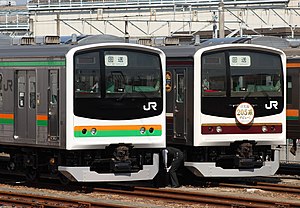205 series
| 205 series | |
|---|---|

A 205 series train on the Musashino Line in January 2017
|
|
| In service | 1985-present |
| Manufacturer | Hitachi, Kawasaki Heavy Industries, Kinki Sharyo, Nippon Sharyo, Tokyu Car Corporation, JR East Ōfuna Works |
| Replaced | 103 series |
| Constructed | 1984-1991 |
| Number built | 1,461 vehicles |
| Formation | 2, 3, 4, 6, 8 or 10 cars per trainset |
| Operator(s) |
JNR (1985-1987) JR East, JR-West (1987-present) KRL Jabodetabek (2013-present) Fuji Kyuko (2011-present) |
| Depot(s) | Miyagino, Nakahara, Keiyō, Kawagoe, Kōzu, Kamakura, Hineno, Miyahara, Depok, Bukit Duri |
| Specifications | |
| Car body construction | Stainless steel |
| Car length | 20,000 mm (65 ft 7 in) |
| Doors | 4 pairs per side 6 pairs per side (SaHa 204) |
| Maximum speed | 100 km/h (Hanwa Line 205-1000 series 110 km/h) |
| Traction system |
Resistor control + field system superimposed field excitation control Variable frequency (IGBT) (205-5000 series) |
| Electric system(s) | 1,500 V DC overhead lines |
| Current collection method | Pantograph |
| Braking system(s) | Regenerative brake, electronically controlled pneumatic brakes |
| Safety system(s) | ATS-SN,ATS-SW,ATS-P, ATS-Ps,ATC,D-ATC |
| Coupling system | Shibata-Type |
| Track gauge | 1,067 mm (3 ft 6 in) |
| Notes | |
| 205-600 series | |
|---|---|

205-600 sets Y8 (left) and Y3 (right) in March 2013
|
|
| In service | 16 March 2013 – |
| Replaced | 107 series |
| Refurbishment | 2012–2013 |
| Number in service | 48 vehicles (12 sets) |
| Formation | 4 cars per set |
| Fleet numbers | Y1–Y12 |
| Operator(s) | JR East |
| Depot(s) | Oyama |
| Line(s) served | Utsunomiya Line, Nikko Line |
| Specifications | |
| Car body construction | Stainless steel |
| Car length | 20,000 mm (65 ft 7 in) |
| Width | 2,800 mm (9 ft 2 in) |
| Doors | 4 pairs per side |
| Maximum speed | 100 km/h (60 mph) |
| Acceleration | 1.7 km/h/s |
| Deceleration | 3.6 km/h/s |
| Electric system(s) | 1,500 V DC |
| Current collection method | overhead |
| Bogies | DT50 (motored), TR235D (trailer) |
| Safety system(s) | ATS-P, ATS-SN |
| Track gauge | 1,067 mm (3 ft 6 in) |
The 205 series (205系 Nihyaku-go-kei?) is a commuter electric multiple unit (EMU) train type introduced in 1985 by Japanese National Railways (JNR), and currently operated by East Japan Railway Company (JR East) and West Japan Railway Company (JR-West).
(in alphabetical order)
There have been many variations of the design of the 205 series trains.
Below is a list of photos for various 205 series designs as indicated by the liveries of the lines they serve.
Yamanote Line 205-0 series set 30 in February 2003
A Keihin-Tohoku Line 205-0 series in February 1992
A Saikyo Line 205-0 series in November 2007
A Yokohama Line 205-0 series in April 2008
Musashino Line (left) and Keiyo Line (right) 205-0 series trains in May 2006
A Nambu Line 205-0 series in April 2011
A Keiyo Line 205-0 series (later design) in May 2008
Musashino Line 205 series (left, later design) and Sagami Line 205-500 series (right) in November 2006
A Nikko Line 205-600 series in March 2013
An Utsunomiya Line 205-600 series in March 2013
A Nambu Branch Line 205-1000 series in August 2009
A Tsurumi Line 205-1100 series in August 2009
A Nambu Line 205-1200 series in October 2014
A Kawagoe/Hachiko Line 205-3000 series in June 2004
A Senseki Line 205-3100 series in July 2006
A Musashino Line 205-5000 series in January 2017
A JR-West 205-0 series in original livery in February 2006. Used on the Tokaido Main Line from 1986-2006 as 7-car sets and on the Hanwa Line as 6- and 8-car sets from 2006 to 2010
A JR-West 205-0 series in Tokaido Main Line livery in March 2011
A JR-West 205-0 series in new Hanwa Line livery in January 2014
A Hanwa Line 205-1000 series train with later design cab window arrangement at Tennoji Station bound for Hineno Station in July 2004
The 205-600 subseries was created in 2013, when cars from former Keiyo Line 10-car sets were reformed between 2012 and 2013 to create twelve four-car sets for use on Nikko Line and Utsunomiya Line services, entering service from 16 March 2013, replacing ageing 107 series and 211 series sets. The four Nikko Line sets are finished in a livery with "classic ruby brown", "gold", and "cream" bodyside stripes. The Utsunomiya Line sets are finished in a livery with Shonan green and orange bodyside stripes.
...
Wikipedia
